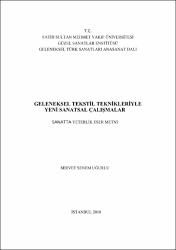Geleneksel tekstil teknikleriyle yeni sanatsal çalışmalar
Künye
UĞURLU, Servet Senem, Geleneksel tekstil teknikleriyle yeni sanatsal çalışmalar, Fatih Sultan Mehmet Vakıf Üniversitesi Güzel Sanatlar Enstitüsü Geleneksel Türk Sanatları Anasanat Dalı, Yayımlanmamış Yüksek Lisans Tezi, İstanbul 2018Özet
Uygarlık tarihi boyunca insanların yaşadığı çevrenin olumsuz etkilerine karşı kullandıkları en önemli objeleri tekstiller olmuştur. Ancak arkeolojik kalıntılar arasında günümüze en az ulaşan nesneler, tekstillerdir. Tarihsel süreç içinde, ilk sanatsal dokumalar, Avrupa’nın resimsel ağırlıklı tapestryleri ile Anadolu’nun halı ve kilimleri olmuştur. Sanatsal dokumalar, Arts & Crafts, Art Nouveau, Art Deco, Bauhaus gibi sanat akımları ile gelişme göstermiştir. Bu akımların sonrasında, periyodik olarak yapılan tekstil sanatı sergileri sayesinde uluslararası tekstil sanatı örnekleri çoğalmıştır. Lozan Bienallerindeki sanatsal tekstiller, bu alanda farklı gelişim ve yeniliklere neden olmuştur. Bu dönemdeki çalışmalarda, tekstilin malzeme, teknik ve geleneksel özellikleri öne çıkarılmıştır. “Geleneksel Tekstil Teknikleriyle Yeni Sanatsal Çalışmalar” başlıklı eser metninde; Anadolu’daki geleneksel tekstil örneklerinin malzeme, teknik ve desen özellikleri incelenmiştir. Geleneksel yöntemle oluşturulan dokusal yüzeylerin halk sanatı, folklor, yöresel ve ulusal örnekleri tespit edilmiştir. Sanatta Yeterlik eğitimi bağlamında uygulaması yapılan eserler için geleneksel tekstil teknikleri ile ulusal dokuma kültürü birikiminden yararlanılmıştır. Anadolu’nun çeyiz geleneği hassasiyeti ile oluşturulmuş, ulusal kimlik özelliğini taşıyan bu yeni sanatsal çalışmalar; günümüz evrensel sanat boyutuna ulaşmayı hedeflemektedir. Throughout the history of civilization, the most important objects people used
against the negative effects of the environment in which they lived have been textiles.
However, among archaeological remains, the objects to reach the present day in
smallest numbers are textiles. Within historical process, the first artistic weavings have
been mainly pictorial tapestries of Europe and Anatolian carpets and (kilim) rugs.
Artistic weavings have progressed with art movements such as Arts & Crafts, Art
Nouveau, Art Deco and Bauhaus. Following these movements, international examples
of textile art have multiplied thanks to periodically held exhibitions of textile art. The
artistic textiles in the Lausanne Biennials have caused various developments and
innovations in this field. During this period of studies, the material, technical and
traditional properties of textile have been brought to the foreward.
In the text document titled “Innovative Artistic Works Through Traditional
Textile Techniques”, the material, technical and design properties of traditional textile
examples in Anatolia have been studied. Folk Art, folklore, regional and national
examples of the textural surfaces created by the traditional method have been
established.
Traditional textiles techniques and accumulation of national weaving culture
have been used for the artworks which are applied in the context of Proficiency in Art
Education. Created with the sensitivity of Anatolia's dowry tradition and having
national identity characteristic, these new artistic works aim to reach the dimension of
today's universal art.



















